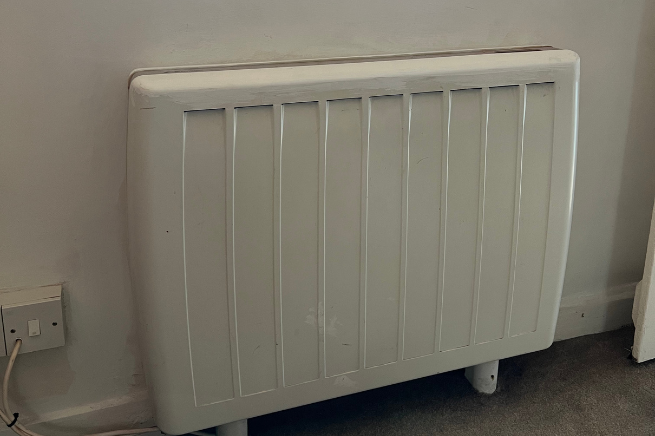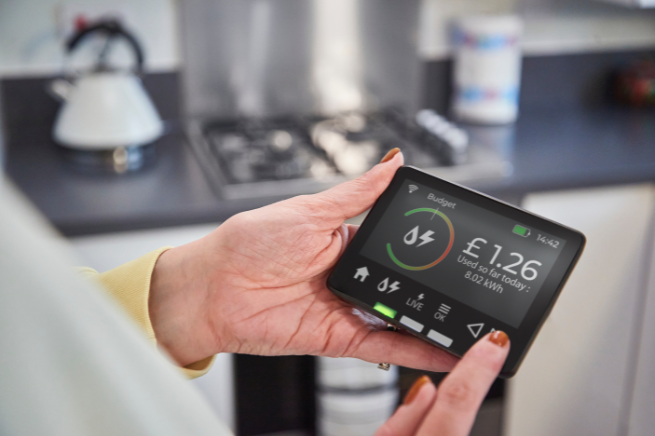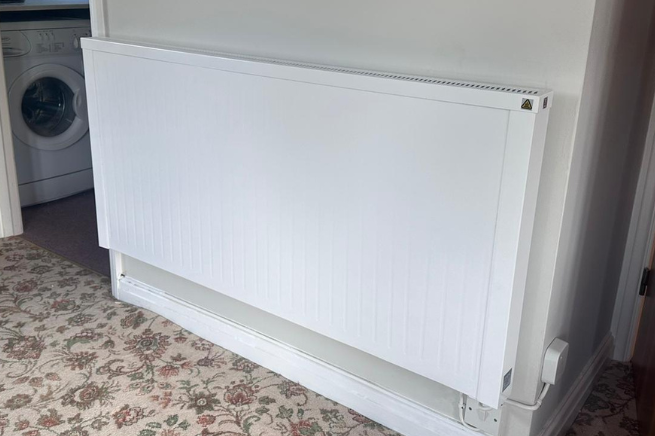
Storage heaters (also called electric storage heaters) are an electric heating system designed to store heat overnight and release it gradually throughout the day. They’re packed with ceramic or clay bricks that heat up using cheaper night-time electricity on tariffs like Economy 7. The idea? Charge them up when electricity is cheap, then let that stored heat trickle out during the day to keep you warm.
Sounds clever in theory, but here’s the catch: once they’ve charged overnight, you’re stuck with whatever heat they’ve stored. Not exactly ideal if the weather changes or you need more warmth later in the day.
Looking for something better? Modern electric radiators like our NEOS electric radiators give you complete control. Unlike storage heaters that rely on off-peak charging and Economy 7 tariffs, NEOS electric radiators are NOT storage heaters. You decide when and how you heat your home, no dependency on off-peak rates and no guessing the weather.
So How Do Storage Heaters Work?
Storage heaters work on thermal storage. During off-peak hours (usually at night), they use electricity to heat up ceramic or high-density bricks inside the unit. These bricks are brilliant at holding onto heat, storing it efficiently until it’s released during the day.
Once the storage heater switches off in the morning, a thermostat gradually releases that stored heat into your room throughout the day, keeping things steady and warm.
The problem? Limited control. Once it’s charged, that’s your lot. Need extra warmth mid-afternoon? You’ll be paying expensive daytime rates for any top-up heat.
NEOS Electric Radiators: A Modern Alternative to Storage Heaters
Here’s the key difference: NEOS electric radiators are NOT storage heaters, they’re modern electric radiators that give you quick heat, with precise control without any Economy 7 dependency.
Storage Heaters vs NEOS Electric Radiators
Storage heaters:
Charge overnight on Economy 7 or off-peak tariffs
Release heat gradually throughout the day with limited control
You can’t adjust heating once they’ve charged
Need extra warmth during the day? You’re paying expensive daytime rates
NEOS electric radiators:
Heat on demand whenever you need it
Precise temperature control in every room
No dependency on off-peak tariffs or Economy 7
Work with any electricity tariff, including smart tariffs like Octopus Cosy
How the NEOS Technology Works Differently
NEOS electric radiators are NOT storage heaters. Here’s why they’re different:
Storage heaters trap heat in ceramic bricks overnight and release it slowly with no real control. The NEOS combines two advanced heating technologies that give you the best of both worlds
Soapstone core: Retains warmth efficiently so the radiator continues giving off gentle heat even after it switches off. But here’s the crucial bit—unlike storage heaters, YOU control exactly when it heats up in the first place. No overnight charging schedules.
Patented back wall technology: Delivers quick, even heating throughout the room and minimises heat loss to the back wall.
What does this mean for you? You get the comfort of retained warmth WITHOUT the limitations of storage heating. You control when each radiator heats up, which rooms stay warm, and exactly when your heating runs, not your electricity tariff.

Electric storage heaters are a specific type of storage heater that runs exclusively on electricity. They operate the same way as other storage heaters—storing heat during off-peak hours and releasing it gradually throughout the day. They’re particularly popular in areas where natural gas or other heating fuels aren’t available.
Inside, electric storage heaters have heating elements that warm up a core material (ceramic bricks or high-density panels). This core acts as the heat storage medium, soaking up and holding onto heat energy for later use. A thermostat and control panel let you regulate the process, but your control is limited once the unit has charged overnight.

An off-peak electricity tariff like Economy 7 is a specialised pricing structure from energy providers. It encourages you to use electricity during lower-demand hours (usually at night) when it’s cheaper. Here’s how it works:
Dual Tariff: Economy 7 gives you two different electricity rates, a lower rate during off-peak hours (overnight) and a higher rate during peak hours (daytime). Your energy provider sets these rates.
Off-Peak Hours: These vary but usually run from late at night until early morning. During these times, your electricity is billed at the lower rate, making it more cost-effective for things like charging storage heaters or electric vehicles.
Benefits: Economy 7 can save you money if you use a lot of electricity during off-peak hours, especially if you have night storage heaters.
The Limitation: Storage heaters REQUIRE Economy 7 or similar off-peak tariffs to be cost-effective whereas the NEOS electric radiators work efficiently with standard and smart electricity tariffs, giving you way more flexibility.
How to Use Night Storage Heaters
If you’ve currently got night storage heaters, here’s how to get the most out of them:
Set the Controls: Most night storage heaters come with controls that allow you to set the input and output levels. Adjust these controls to match your heating needs and the weather conditions. Typically, you should set them in the evening for the following day.
Take Advantage of Off-Peak Rates: If you have an off-peak electricity tariff, ensure your storage heaters charge during the cheaper, off-peak hours.
Avoid Overheating: Be cautious about overloading the storage heater with excessive heat. Overcharging can lead to wasted energy and discomfort. Adjust the controls as needed.
Ventilation: Ensure that there’s adequate ventilation in the room to prevent condensation and mould growth, especially in well-insulated homes.
Regular Maintenance: Periodically clean your storage heater’s vents and elements, and have it professionally inspected to maintain its efficiency.
Tips for Using Storage Heaters
Looking for ways to use your storage heaters more efficiently? Try these:
Optimise Timing: Set your storage heaters to charge during off-peak hours and release heat during the day when you need it most.
Room Ventilation: Keep a slight window or door opening to ensure proper air circulation, preventing excessive humidity and condensation.
Zoning: If possible, use individual heaters for different zones or rooms to better control the temperature in each area.
Weather Adjustment: Adjust the settings based on weather forecasts. During colder spells, you may need to increase the heat output.
Insulation: Improve your home’s insulation to reduce heat loss and maximise the effectiveness of storage heaters.

Look, storage heaters have served many homes well over the years. But let’s be honest, they come with serious limitations. You’re restricted to off-peak charging, you’ve got limited control over heat release, and you’re tied to Economy 7 tariffs.
If you’re looking for a modern alternative that gives you complete control over your heating, our NEOS range of electric radiators offers a smarter, more flexible solution.
NEOS electric radiators are NOT storage heaters. They’re advanced electric radiators that combine:
Instant, on-demand heating with precise control
Soapstone core technology for lasting warmth
Doubled convection for fast, even heat distribution
No dependency on off-peak tariffs
British-made quality with a 25-year guarantee
One of the slimmest designs on the market at only 6.5cm
Ready to explore the full potential of NEOS? Download our FREE brochure and discover how NEOS can transform your daily comfort while giving you the control that storage heaters simply can’t offer.
Don’t settle for the limitations of storage heating. Download your free NEOS brochure today and take the first step towards a warmer, more efficient, and eco-friendly home with complete heating control.
Tags: Scott, Comparisons.

If you are considering electric heating/electric radiators, then this guide tells you everything you need to know. Discover this modern, sustainable and economical method of heating that gives you complete control and comfort. Download Free Guide now.

*Trust Electric Heating needs the contact information you provide to us to contact you about our products and services. You may unsubscribe from these communications at any time. For information on how to unsubscribe, as well as our privacy practices and commitment to protecting your privacy, check out our Privacy Policy.
Quick installation and a 100 day warmth guarantee. Whether you’re buying one or several radiators, if our radiators don’t heat your room to a minimum of 20 degrees we will undertake to upgrade or replace the radiators free of charge.
Book your free consultation